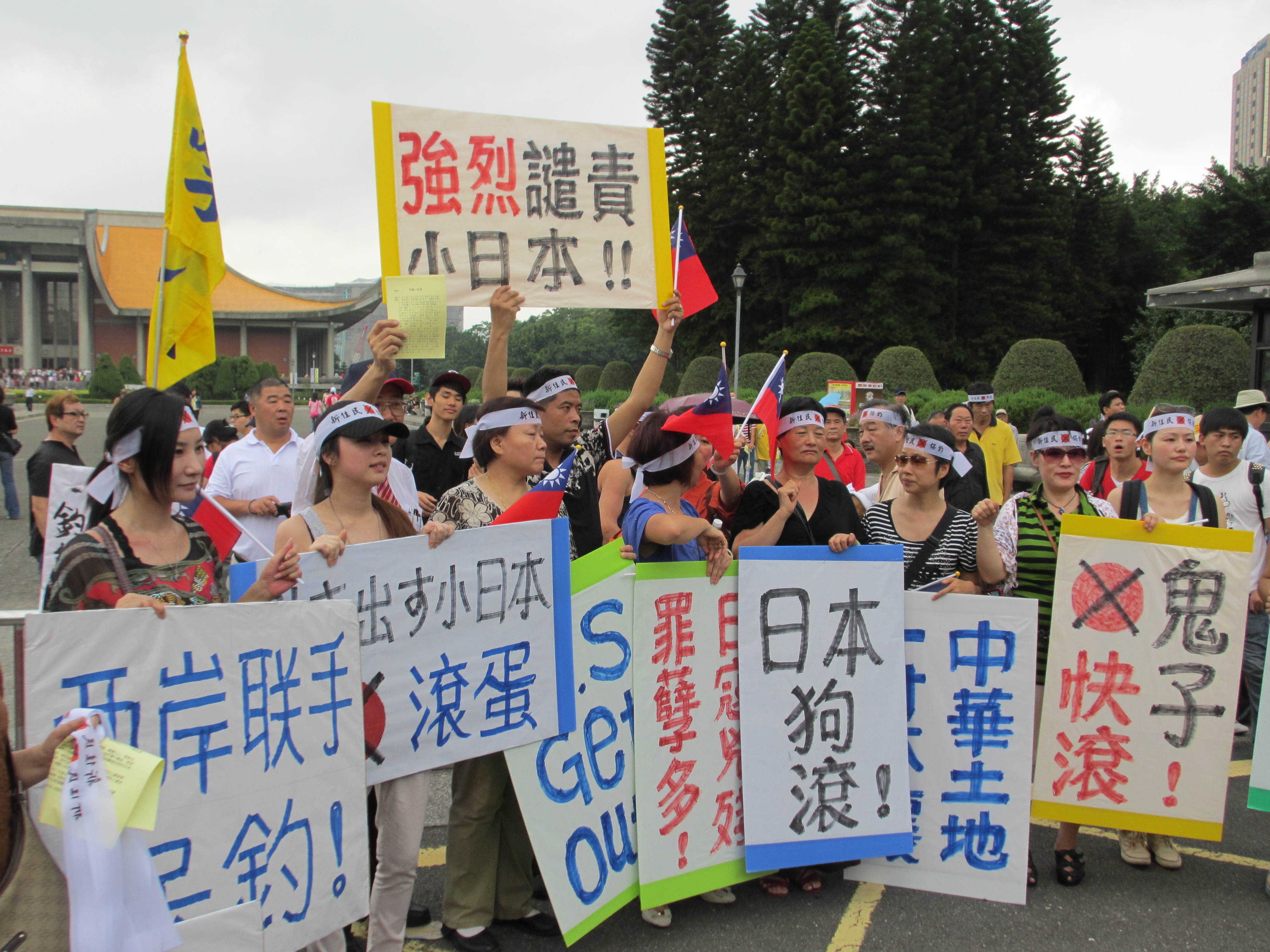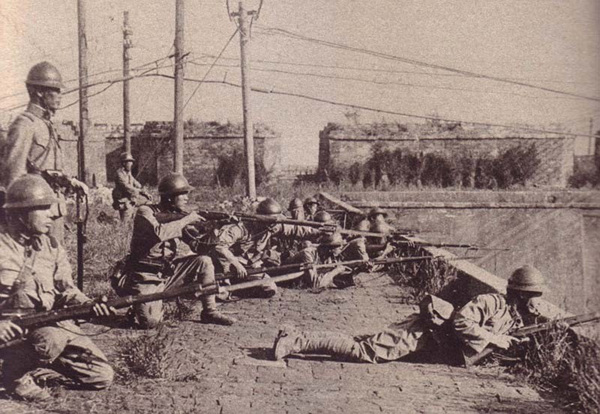|
Anti-Japanese Sentiment In China
Modern anti-Japanese sentiment in China is frequently rooted in nationalist or historical conflicts, for example, it is rooted in the atrocities and the war crimes which Imperial Japan committed in China during the First Sino-Japanese War, the Boxer Rebellion (Eight-Nation Alliance), the Siege of Tsingtao, the Second Sino-Japanese War and Japan's history textbook controversies. Bitterness persists in China as a result of the Second Sino-Japanese War and Japan's post-war actions. At least to some extent, this sentiment may also be influenced by issues which affect Chinese people in Japan. According to a 2017 BBC World Service poll, mainland Chinese people hold the largest anti-Japanese sentiment in the world, with 75% of Chinese people viewing Japan's influence negatively, and 22% expressing a positive view. Anti-Japanese sentiment in China was at its highest in 2014 since the poll was first conducted in 2006 and was up 16 percent over the previous year. However, anti-Japanese s ... [...More Info...] [...Related Items...] OR: [Wikipedia] [Google] [Baidu] |
Anti-japanese Banner Lijiang
Anti-Japanese sentiment (also called Japanophobia, Nipponophobia and anti-Japanism) is the fear or dislike of Japan or Japanese culture. Anti-Japanese sentiment can take many forms, from antipathy toward Japan as a country to racist hatred of Japanese people. Overview Anti-Japanese sentiments range from animosity towards the Japanese government's actions during the Second Sino-Japanese War and Pacific War, World War II, to Contempt, disdain for Japanese culture, or to racism against the Japanese people. Sentiments of dehumanization have been fueled by the American propaganda during World War II#Anti-Japanese, anti-Japanese propaganda of the Allies of World War II, Allied governments in World War II; this propaganda was often of a racially disparaging character. Anti-Japanese sentiment may be strongest in Korea and China, due to Japanese war crimes, atrocities committed by the Imperial Japanese Armed Forces, Imperial Japanese military. In the past, anti-Japanese sentiment ... [...More Info...] [...Related Items...] OR: [Wikipedia] [Google] [Baidu] |
Ming Dynasty
The Ming dynasty, officially the Great Ming, was an Dynasties of China, imperial dynasty of China that ruled from 1368 to 1644, following the collapse of the Mongol Empire, Mongol-led Yuan dynasty. The Ming was the last imperial dynasty of China ruled by the Han people, the majority ethnic group in China. Although the primary capital of Beijing fell in 1644 to a rebellion led by Li Zicheng (who established the short-lived Shun dynasty), numerous rump state, rump regimes ruled by remnants of the House of Zhu, Ming imperial family, collectively called the Southern Ming, survived until 1662. The Ming dynasty's founder, the Hongwu Emperor (1368–1398), attempted to create a society of self-sufficient rural communities ordered in a rigid, immobile system that would guarantee and support a permanent class of soldiers for his dynasty: the empire's standing army exceeded one million troops and the naval history of China, navy's dockyards in Nanjing were the largest in the world. H ... [...More Info...] [...Related Items...] OR: [Wikipedia] [Google] [Baidu] |
Japanese Invasion Of Manchuria
The Empire of Japan's Kwantung Army invaded the Manchuria region of the Republic of China on 18 September 1931, immediately following the Mukden incident, a false flag event staged by Japanese military personnel as a pretext to invade. At the war's end in February 1932, the Japanese established the puppet state of Manchukuo. The occupation lasted until mid-August 1945, towards the end of the Second World War, in the face of an onslaught by the Soviet Union and Mongolia during the Manchurian Strategic Offensive Operation. With the invasion having attracted great international attention, the League of Nations produced the Lytton Commission (headed by British politician Victor Bulwer-Lytton) to evaluate the situation, with the organization delivering its findings in October 1932. Its findings and recommendations that the Japanese puppet state of Manchukuo not be recognized and the return of Manchuria to Chinese sovereignty prompted the Japanese government to withdraw from the L ... [...More Info...] [...Related Items...] OR: [Wikipedia] [Google] [Baidu] |
Hui People
The Hui people are an East Asian ethnoreligious group predominantly composed of Islam in China, Chinese-speaking adherents of Islam. They are distributed throughout China, mainly in the Northwest China, northwestern provinces and in the Zhongyuan region. According to the 2010 census, China is home to approximately 10.5 million Hui people. Outside China, the 170,000 Dungan people of Kazakhstan and Kyrgyzstan, the Panthays in Myanmar, and many of the Chin Haws in Thailand are also considered part of the Hui ethnicity. The Hui were referred to as Hanhui during the Qing dynasty to be distinguished from the Turkic peoples, Turkic Muslims, which were referred to as Chanhui. The Republic of China (1912–1949), Republic of China government also recognised the Hui as a branch of the Han Chinese rather than a separate ethnic group. In the National Assembly (Republic of China), National Assembly of the Republic of China, the Hui were referred to as 1947 Chinese National Assembly election ... [...More Info...] [...Related Items...] OR: [Wikipedia] [Google] [Baidu] |
Dungan People
Dungan, , Xiao'erjing: ; , ''Dungane''; , ''Duñgandar'', دۇنغاندار; , ''Düñgender'', دٷڭگەندەر is a term used in territories of the former Soviet Union to refer to a group of Muslim people of Hui origin. Turkic-speaking peoples in Xinjiang also sometimes refer to Hui Muslims as Dungans. In both China and the former Soviet republics where they reside, however, members of this ethnic group call themselves Hui because Dungans are descendants of historical Hui groups that migrated to Central Asia. In the censuses of the countries of the former Soviet Union, the Dungans (enumerated separately from Chinese) are found in Kazakhstan (36,900 according to the 1999 census), Kyrgyzstan (58,409 according to the 2009 census) and Russia (801 according to the 2002 census). [...More Info...] [...Related Items...] OR: [Wikipedia] [Google] [Baidu] |
Boycott Of Japanese Products
Boycotts of Japanese products have been conducted by numerous Korean, Chinese and American civilian and governmental organizations in response to real or disputed Japanese aggression and atrocities, whether military, political or economic. 20th century The first boycott of Japanese products in China was started 1915 as a result of public indignation at the Twenty-One Demands which Japan forced China to accept. In 1919, the students and intellectuals involved in the May Fourth Movement called for another boycott of Japanese products, developing into a mass movement across China, including general strikes. Local chambers of commerce decided to sever economic ties with Japan, workers refused to work in Japanese-funded factories, consumers refused to buy Japanese goods, and students mobilised to punish those found selling, buying or using Japanese products. The Jinan Incident of 1928 prompted a new boycott. This time, the Kuomintang government mobilised the Chinese population to ... [...More Info...] [...Related Items...] OR: [Wikipedia] [Google] [Baidu] |
Twenty-One Demands
The Twenty-One Demands (; ) was a set of demands made during the World War I, First World War by the Empire of Japan under Prime Minister of Japan, Prime Minister Ōkuma Shigenobu to the Government of the Chinese Republic, government of the Republic of China (1912–49), Republic of China on 18 January 1915. The secret demands would greatly extend Japanese control of China. Japan would keep the former German areas it had conquered at the start of World War I in 1914 and would be strong in History of Manchuria#Russian and Japanese encroachment, Manchuria and South Mongolia while having an expanded role in railways. The most extreme demands (in section 5) would give Japan a decisive voice in finance, policing, and government affairs. The last part would make China in effect a protectorate of Japan, and thereby reduce Western influence. Japan was in a strong position during the course of the war as the Allies of World War I, Allies were in a stalemate with their rivals, the Centra ... [...More Info...] [...Related Items...] OR: [Wikipedia] [Google] [Baidu] |
Joseon
Joseon ( ; ; also romanized as ''Chosun''), officially Great Joseon (), was a dynastic kingdom of Korea that existed for 505 years. It was founded by Taejo of Joseon in July 1392 and replaced by the Korean Empire in October 1897. The kingdom was founded following the aftermath of the overthrow of Goryeo in what is today the city of Kaesong. Early on, Korea was retitled and the capital was relocated to modern-day Seoul. The kingdom's northernmost borders were expanded to the natural boundaries at the rivers of Yalu River, Amnok and Tumen River, Tuman through the subjugation of the Jurchen people, Jurchens. During its 500-year duration, Joseon encouraged the entrenchment of Korean Confucianism, Confucian ideals and doctrines in Korean society. Neo-Confucianism was installed as the new state's ideology. Korean Buddhism, Buddhism was accordingly discouraged, and occasionally Buddhists faced persecution. Joseon consolidated its effective rule over the Korean peninsula and saw the he ... [...More Info...] [...Related Items...] OR: [Wikipedia] [Google] [Baidu] |
Ryukyu Kingdom
The Ryukyu Kingdom was a kingdom in the Ryukyu Islands from 1429 to 1879. It was ruled as a Tributary system of China, tributary state of Ming dynasty, imperial Ming China by the King of Ryukyu, Ryukyuan monarchy, who unified Okinawa Island to end the Sanzan period, and extended the kingdom to the Amami Islands and Sakishima Islands. The Ryukyu Kingdom played a central role in the maritime history, maritime trade networks of medieval East Asia and Southeast Asia despite its small size. The Ryukyu Kingdom became a vassal state of the Satsuma Domain of Japan after the invasion of Ryukyu in 1609 but retained ''de jure'' independence until it was transformed into the Ryukyu Domain by the Empire of Japan in 1872. The Ryukyu Kingdom was Ryukyu Disposition, formally annexed and dissolved by Japan in 1879 to form Okinawa Prefecture, and the Ryukyuan monarchy was integrated into the new Kazoku, Japanese nobility. History Origins of the Kingdom In the 14th century small domains s ... [...More Info...] [...Related Items...] OR: [Wikipedia] [Google] [Baidu] |
Empire Of Japan
The Empire of Japan, also known as the Japanese Empire or Imperial Japan, was the Japanese nation state that existed from the Meiji Restoration on January 3, 1868, until the Constitution of Japan took effect on May 3, 1947. From Japan–Korea Treaty of 1910, 1910 to Japanese Instrument of Surrender, 1945, it included the Japanese archipelago, the Kuril Islands, Kurils, Karafuto Prefecture, Karafuto, Korea under Japanese rule, Korea, and Taiwan under Japanese rule, Taiwan. The South Seas Mandate and Foreign concessions in China#List of concessions, concessions such as the Kwantung Leased Territory were ''de jure'' not internal parts of the empire but dependent territories. In the closing stages of World War II, with Japan defeated alongside the rest of the Axis powers, the Japanese Instrument of Surrender, formalized surrender was issued on September 2, 1945, in compliance with the Potsdam Declaration of the Allies of World War II, Allies, and the empire's territory subsequent ... [...More Info...] [...Related Items...] OR: [Wikipedia] [Google] [Baidu] |
Qing Dynasty
The Qing dynasty ( ), officially the Great Qing, was a Manchu-led Dynasties of China, imperial dynasty of China and an early modern empire in East Asia. The last imperial dynasty in Chinese history, the Qing dynasty was preceded by the Ming dynasty and succeeded by the Republic of China (1912–1949), Republic of China. At its height of power, the empire stretched from the Sea of Japan in the east to the Pamir Mountains in the west, and from the Mongolian Plateau in the north to the South China Sea in the south. Originally emerging from the Later Jin (1616–1636), Later Jin dynasty founded in 1616 and proclaimed in Shenyang in 1636, the dynasty seized control of the Ming capital Beijing and North China in 1644, traditionally considered the start of the dynasty's rule. The dynasty lasted until the Xinhai Revolution of October 1911 led to the abdication of the last emperor in February 1912. The multi-ethnic Qing dynasty Legacy of the Qing dynasty, assembled the territoria ... [...More Info...] [...Related Items...] OR: [Wikipedia] [Google] [Baidu] |









